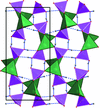issue contents
August 2019 issue

Cover illustration: Two 1,4,5,6-tetrahydrobenzo[h]quinazolin-2-amine derivatives were synthesized and their structures were confirmed by single-crystal X-ray diffraction. They showed better water solubility and better anti-inflammatory activity than the starting ketones. See Sun, Gao, Wang & Hou [Acta Cryst. (2019), C75, 1157-1165].
scientific commentaries

research papers




























 access
access













 journal menu
journal menu






































